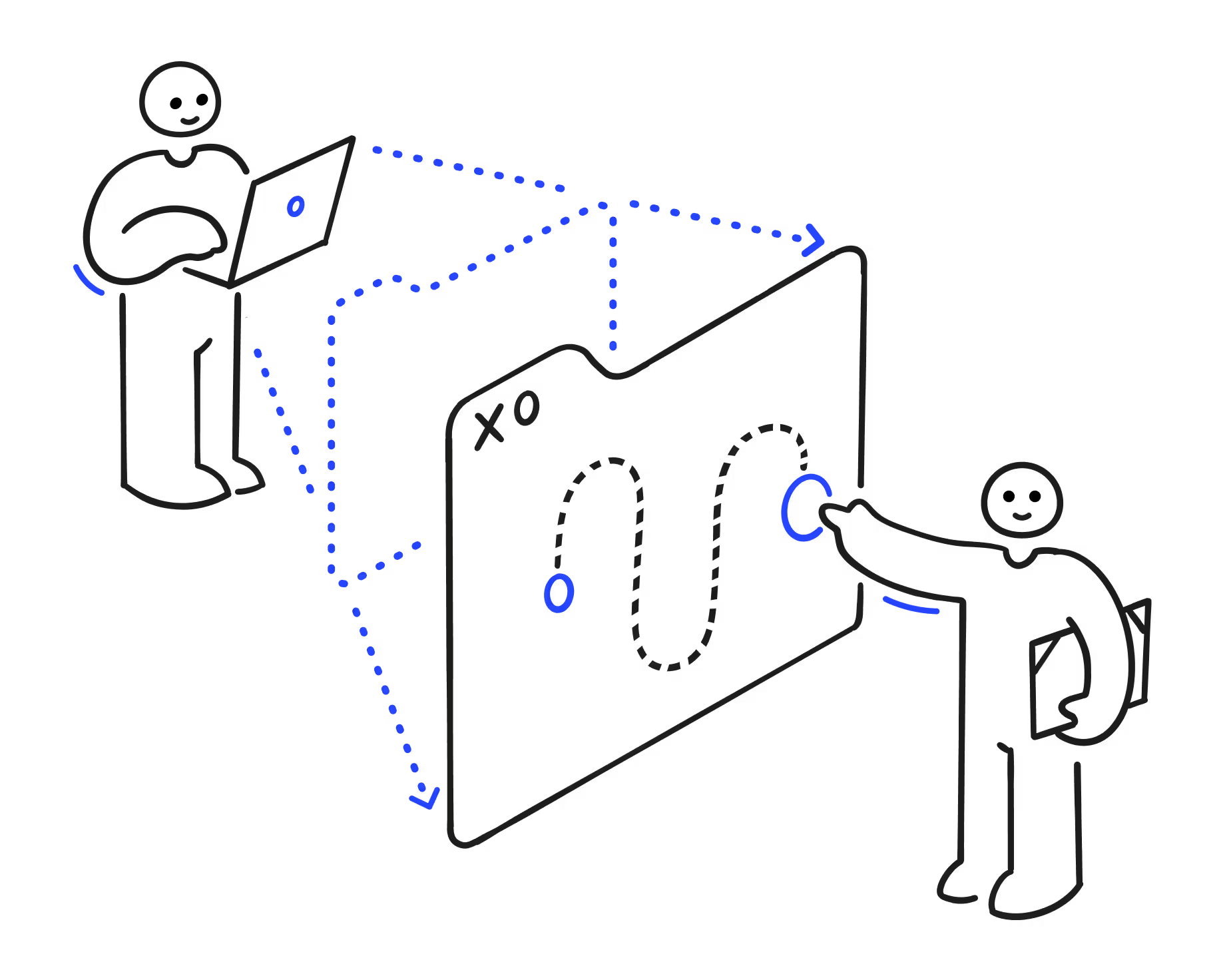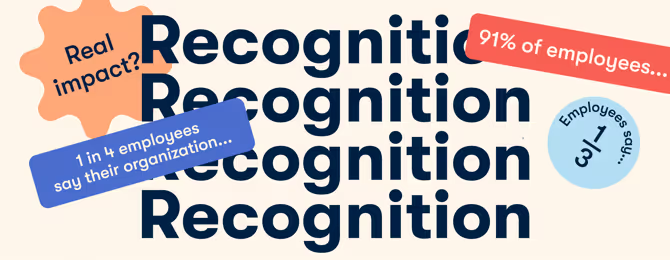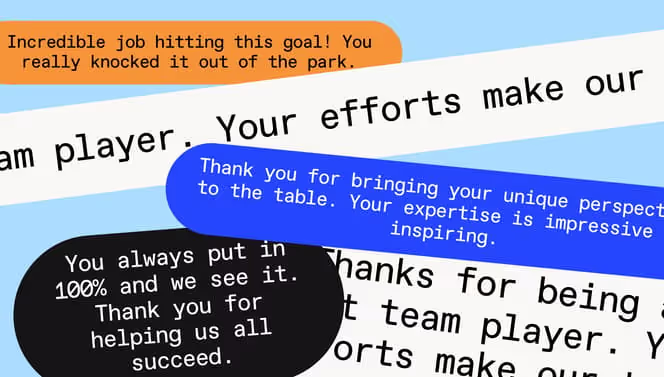20 Employee recognition survey questions

Discover Workleap Officevibe's benchmark report on 12 key employee engagement metrics

Employees are arguably an organization’s most valuable assets. So it makes sense that having optimal employee performance is key to ensuring a company’s long-term survival.
Keeping your team happy and engaged can help you maximize profitability and provide a consistently pleasant customer experience – and setting up a recognition program will let you do just that.
We understand that as a manager or supervisor it can be challenging to promote employee satisfaction while:
- Treating all team members fairly
- Setting clear expectations
- Establishing trust and healthy peer relationships
- Addressing conflict and other roadblocks
- Understanding everyone’s challenges, aspirations, and motivations
Overcoming this challenge, with the support of your management team, makes it possible to implement a dynamic employee recognition program to boost employee engagement and productivity.
To help you understand your team’s needs and expectations, we’ve put together 20 employee recognition questions for your next survey.
The importance of employee recognition
Recognition occurs when an employee receives an acknowledgment for their contributions to their team and/or organization. These contributions include consistent performance, new ideas, and professional behavior.
According to an analysis by Gallup, 74% of employees who say their team receives regular recognition strongly agree that they feel their work is valuable and useful. It’s clear then that implementing a vibrant recognition program is the key to:
- Providing employees with a sense of accomplishment
- Enhancing employee engagement
- Establishing company loyalty
- Improving employee productivity
- Maximizing employee retention and saving costs
Creating an employee recognition survey is an effective way to gauge how employees feel about the current recognition program and identify areas for improvement.
20 employee recognition survey questions
Including the questions below in your employee recognition surveys will allow your employees to give feedback and helpful suggestions to improve their employee experience. Using the answers to these questions, you can pinpoint problem areas and formulate optimal solutions for your team.
1. How often do you receive recognition?
How frequently employees receive recognition for their contributions plays a role in how appreciated they feel.
One-on-one meetings with employees are the ideal opportunity for managers to acknowledge stand-out work or an innovative idea. If employees indicate that they only receive recognition once per month or even less often, you should start making improvements to your recognition program.
{emphasize}💡 Pro tip: Employees should receive recognition, either from their managers or peers, at least once a week.{emphasize}
2. Do you feel you receive enough recognition?
Each employee is unique. Some individuals require daily recognition to feel valued at the workplace, while others might not know how to respond to recognition or may feel uncomfortable with praise. This question in the employee recognition survey indicates whether or not the existing program is sufficient.
{emphasize}For example, if employee responses show that your team is happy with a yearly reward, implementing a daily or weekly appreciation program may be unnecessary.{emphasize}
3. Is the recognition you receive meaningful?
The employee recognition survey should give insight into how relevant and substantial your organization’s rewards are. If an employee doesn’t find the existing rewards valuable, upping the frequency might not be the right solution. They may be looking to receive meaningful rewards instead.
{emphasize}For example, some employees prefer acknowledgment in front of their peers, while others may feel appreciated with a private message. Each organization needs to determine whether the form of recognition it offers is effective, and then make changes accordingly.{emphasize}
4. Do you feel valued at the company?
Employees want to feel that their daily activities, work ethic, or ideas contribute to the company’s success. When employees know they play a specific invaluable role within the organization, they are more likely to stay on which boosts employee retention rates and creates a more positive work culture.
{emphasize}💡Pro tip: You can easily show employees that their roles are valuable through clear communication. Being attentive to an employee’s wins and giving real-time kudos will help your team feel appreciated.{emphasize}
5. Do you know which behaviors receive recognition?
Employees should clearly understand the behaviors that receive recognition within your company. When your team knows what is most important to your organization, they are more likely to focus on these tasks.
{emphasize}💡Pro-tip: One-on-one meetings or training initiatives are effective ways to let employees know what the company expects of them.{emphasize}
6. Which behaviors should receive recognition?
This employee recognition survey question prompts employees to consider other achievements that managers should acknowledge. Because employees deliver products and services, interact with customers, and collaborate with vendors, they can identify efforts that are integral to the company’s success.
{emphasize}Managers might not be in tune with which tasks are necessary to retain customers. In the survey, employees can indicate that personalizing offers and selling loyalty programs are the reasons customers return. These tactics and initiatives should receive recognition.{emphasize}
7. Which recognition type do you value most?
As managers, it’s important to know what part of your recognition program is the most valuable to employees. Making changes according to these survey results is simple and will make sure your program runs more effectively.
{emphasize}Officevibe can help give your team a safe space where they can be honest about the type of employee recognition they value.{emphasize}
8. What rewards would you like to receive?
If you’re missing the mark with the previous question, you may need to reevaluate the rewards you're offering altogether. Asking employees what they'd like to receive can give you more clarity.
Providing valuable rewards ensures that employees find the recognition meaningful and motivating. At Officevibe, we strongly believe that non-monetary recognition, such as verbal or written praise, peer-to-peer acknowledgment, or leader-to-team recognition, leads to more intrinsic motivation than to monetary perks.
{emphasize}💡Pro-tip: Consider asking this question in multiple-choice format. Employees’ recognition preferences should align with your organization’s resources.{emphasize}
9. Is the company’s recognition program fair?
Keeping things fair promotes a healthy company culture. This can be as simple as recognizing two employees if they both worked on a successful project.
{emphasize}💡Pro-tip: Set personal relationships aside when recognizing employees. Remaining unbiased makes sure all employees are satisfied with the recognition program.{emphasize}
10. Are the recognition benefits proportional to achievements?
Do employees believe that the recognition they receive is appropriate for their achievements or milestones? Recognition can be tiered according to the impact a person’s work or efforts have on the team and/or organization.
{emphasize}For example, if a team member proposes a new process that will streamline their team’s work, they can receive kudos during their next team sync. On the other hand, if someone secures the biggest client of the year, a company-wide shoutout may be worth giving.{emphasize}
11. How can HR improve the recognition program?
If you have difficulty coming up with ways to recognize employees and improve employee satisfaction, why not ask them what they want?
Your employees likely spend a lot of time thinking about how the company can show them they are appreciated. Adding this question to the survey allows them to give their valuable input anonymously.
{emphasize}With Officevibe, you can give your team members a stake in their own development.{emphasize}
12. How accessible do you find recognition benefits?
Having an accessible program can be as simple as ensuring your employees know the program exists and making all the recognition tools easy to find and use. If employees need to jump through hoops to view or access their praise after earning it, you may need to rethink how your organization tackles recognition.
If the employee recognition survey answers indicate that the program is complicated or time-intensive, be sure to find a way to improve their experience.
{emphasize}💡Pro-tip: Having a centralized and user-friendly platform like Officevibe can make your recognition program intuitive for the entire team. {emphasize}
13. How frequently do you give others recognition?
For a culture of recognition to thrive, showing recognition is just as important as receiving it. Implementing a peer feedback loop is effective and can motivate employees to be excellent team players.
In organizations where employees recognize the accomplishments of others, employee experience tends to reflect the company values.
{emphasize}💡Pro-tip: Encourage employees to provide weekly feedback and acknowledgments to each other. This can be done verbally during a coffee chat, or by sending Good Vibes on Officevibe.{emphasize}
14. Is the recognition for additional effort sufficient?
Some employees have the inherent need to go the extra mile for their employer. Those who go above and beyond should always receive recognition from company management.
This survey question provides valuable insights into how the company treats high achievers. You can optimize these employees’ efforts by making the necessary improvements to the recognition system.
{emphasize}💡Pro-tip: If an employee consistently performs well, it’s important to schedule one-on-one time to understand their career goals and how you can play a role in their personal growth.{emphasize}
15. How easy is recognition across geo-locations?
Employee recognition is critical in a distributed workforce. Building personal relationships can be challenging when dealing with remote teams, and you might also have difficulty determining a remote employee’s motivators. Asking this question can help you make sure you have a team of engaged employees, no matter where they work.
{emphasize}💡Pro tip: If remote workers participate in the employee recognition survey, ask them if they find the acknowledgments from the organization meaningful. These answers can help you make improvements to establish loyalty among all employees.{emphasize}
16. When did you last receive recognition from management?
Communication gaps may exist between management and their direct reports.
For example, team leaders might believe that they regularly acknowledge employee contributions. But if the employee recognition survey indicates that several weeks have passed since employees received an acknowledgment, they might not realize that management recognizes their achievements. This can allow managers to assess and revisit how they are giving kudos.
17. What is the impact of recognition on employee morale?
The ultimate goal of an employee recognition program is to keep your team happy and engaged. Asking this question will help you determine if the current program is effective in keeping employee engagement levels high and boosting your team’s morale.
{emphasize}💡Pro-tip: In some cases, acknowledging one employee’s achievement can enhance the general mood of an entire office. This simple act of appreciation can be a source of inspiration for other employees and can even carry a domino effect.{emphasize}
18. Does the organization reward new ideas?
Through employee recognition, a company can incentivize team members to come up with new ideas to improve efficiency.
The survey answers to this question should indicate that employees are satisfied with the acknowledgment of a new idea. If the answers highlight a pain point, you’ll be better equipped to come up with a solution.
{emphasize}💡Pro-tip: Let people in your organization know that you value innovation by creating an innovation board or Slack channel where everyone can share new ideas.{emphasize}
19. How does employee acknowledgment impact the work environment?
Digging deeper, does acknowledging employee performance affect the general mood and productivity of the team?
Giving kudos is a win-win situation for both employees and organizations. When employees feel recognized, not only do they feel motivated to do their best work, but they can also see a clearer picture of how their work impacts the company’s goals. A pleasant work environment is essential to ensure company-wide efficiency and productivity.
20. Does the company culture promote employee satisfaction?
Once you start building a culture of recognition, you’ll want to measure if there is a clear connection between the appreciation given and the levels of employee satisfaction.
Do employees feel motivated after receiving kudos? Do they recognize employee engagement efforts set forth by the company? This will help you identify the efficacy of your recognition programs and allow you to make any tweaks to improve them.
{emphasize}💡Pro-tip: Consider following up your recognition questionnaire with an employee engagement survey to better understand how the two align.{emphasize}
How to create employee recognition surveys
Creating pulse surveys is one of the most effective ways to collect employee feedback. These feedback tools give you a real-time, bird’s eye view of your team’s employee recognition requirements so that you can make informed decisions.
An employee engagement survey is also viable if you need to keep track of remote teams.
Employee recognition ideas to improve employee engagement
Effective ways to recognize employee achievements include:
- Scheduling one-on-one meetings and carving out time for kudos
- Promoting employee feedback within a virtual setting, like sending Good Vibes on Officevibe
- Acknowledging team members’ contributions during company-wide projects
- Celebrating employees’ milestones
How Officevibe can help
As a Pulse Survey platform, Officevibe lets you measure 10 metrics and 26 sub-metrics of staff satisfaction, including wellness and recognition. Using Pulse Surveys, you can collect employee feedback from targeted questions more frequently, which means you don’t add to your team members’ workflow.
Using Officevibe, you can track metrics like recognition quality and frequency. You can also generate a visual report that overviews employee satisfaction and problem areas needing attention.
Want to talk with our team about how Officevibe might help your organization? Request a demo today where we'll get the conversation going!
Give HR and managers the clarity, confidence, and connection to lead better every day.


%20(1).avif)


.avif)
.avif)








